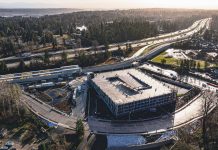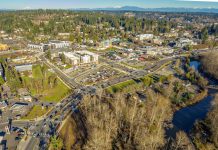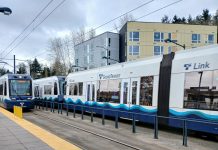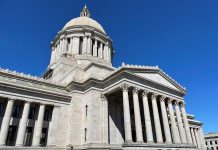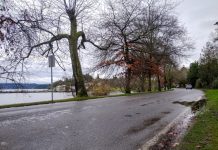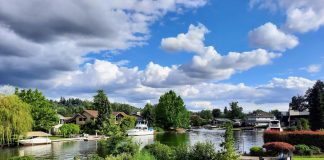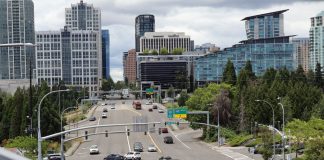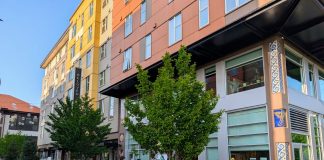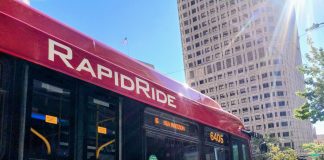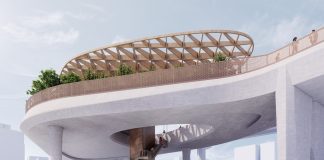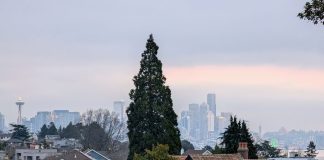More recent posts »
King County is seeking to site a walk-in mental health crisis center in Capitol Hill, but a group of local business owners and residents are pushing back. Health care providers have backed the location, and Seattle Councilmember Alexis Mercedes Rinck has emerged as a vocal proponent, while her colleagues and Mayor Bruce Harrell have mostly withheld support.
Recent Posts
Federal Way Light Rail Extension On Track for Early Opening
Light rail riders are poised to be able to take 1 Line trains all the way to Downtown Federal Way before the end of 2025, thanks to work accelerating the grand opening. That will pave the way for a full opening of the 2 Line across Lake Washington by spring of 2026.
Bothell Drops Parking Mandates, Legalizes Neighborhood Corner Stores Citywide
Bothell becomes the first city in either King or Snohomish County to fully eliminate off-street parking mandates in order to reduce costs for homebuilding. The move clearly solidifies the city as a leader on housing and land use reform.
Seattle Council To Pave the Way for Sound Transit 3 Permitting
Two votes next week will align the City of Seattle with Sound Transit, opening the door to West Seattle Link Extension permit applications later this year. The move comes right on the heels of an overhaul of the city's land use code's light rail provisions.
Op-Ed: How to De-Trumpify the Washington State Budget
The mega wealthy are gaining even greater wealth thanks to Trump tax cuts while hundreds of thousands people are set to lose health care, food stamps, child care, and K-12 educational necessities. The Washington State Legislature should pass progressive funding to maintain and rebuild public services, John Burbank argues.
Promised Lake Washington Boulevard Traffic Calming Remains Uncompleted
Seattle Parks and Recreation rolled out plans to add traffic calming to Lake Washington Boulevard last year. But traffic safety advocates are pushing for answers after installation of those upgrades stopped midway through without explanation.
Get Early-Bird Tickets for The Urbanist’s August 17th Endorsed Candidate Party
Get your ticket to meet our endorsed candidates, mingle with urbanists from across the region, and prepare for the general election in November.
Sunday Video: New York Is Tackling Traffic Through Congestion Pricing
Rollie Williams of Climate Town dives into the long history of how road congestion pricing came to be and why it provides so many social, economic, and environmental upsides for the New York region.
Get Early-Bird Tickets for The Urbanist’s August 17th Endorsed Candidate Party
Get your ticket to meet our endorsed candidates, mingle with urbanists from across the region, and prepare for the general election in November.
Get Your Tickets for ‘Urbanism on the Eastside’ Panel July 6th
RSVP to The Urbanism on the Eastside Panel and join representatives from across the Eastside as they answer questions about housing, land use, and transportation.
Join The Urbanist for June Events, Eastside Forum on July 6th
Headlining our June events, we urge folks to attend the Seattle Comprehensive Plan public comment session on June 23. The Urbanist is also hosting an "Urbanism on the Eastside" panel on Sunday, July 6.
More events posts »
Support Our Work
The Urbanist is a 501(c)(4) nonprofit. We depend on donations from readers like you to sustain our work. Subscribe as a monthly donor or make a one-time donation to help us grow.
Bothell Drops Parking Mandates, Legalizes Neighborhood Corner Stores Citywide
Bothell becomes the first city in either King or Snohomish County to fully eliminate off-street parking mandates in order to reduce costs for homebuilding. The move clearly solidifies the city as a leader on housing and land use reform.
King County Advances K Line Designs for Eastside’s Next RapidRide
The adoption of a locally preferred alternative allows Metro to fully advance design work while seeking federal funding. Outstanding questions remain, including how bus priority will be added along a contentious segment in Houghton.
Bellevue Creates Special City Office for ‘Grand Connection’ Pedestrian Corridor
Former Seattle permitting director Nathan Torgelson will lead the new city department, intended to advance an ambitious plan for a new bike and pedestrian bridge over I-405. One of the largest capital projects in city history, it's also intended to be a major placemaking project.
More Eastside Coverage posts »
Op-Ed: Seattle Council Should Scale Up Neighborhood Centers in Growth Plan
On Monday, June 23, the Seattle City Council is holding a public hearing on the One Seattle growth plan. Housing advocates must defend the 29 neighborhood centers in the plan and push to add more. Jazmine Smith lays out the case for these eight additions.
Harrell Official Minimizes Cuts to Housing Growth Centers as ‘Very Small’
After dozens of blocks were dropped from the One Seattle housing growth plan, planner Michael Hubner downplayed the changes as minimal. The Seattle Planning Commission painted the move as pushing the city is headed in the wrong direction.
Judge Dismisses Last-Ditch Challenges of Draft Seattle Growth Plan
Quick decisions by a King County Superior Court ruled that two separate challenges to the One Seattle Plan's environmental review will have to wait until the Seattle City Council makes a final decision on the growth plan.
More One Seattle Plan posts »
An Audio Recap of The Urbanist’s ‘Future of Seattle Housing’ Panel
Want a deep dive on the latest in Seattle housing policy? The Urbanist has you covered. Check out this recording and transcript of our April housing panel with experts.
Urbanist Reporters Appear on Hacks and Wonks Podcast
The Urbanist's contributing editor Ryan Packer and reporter Amy Sundberg appeared on back-to-back episodes of the Hacks and Wonks podcast this week. Be sure...
Ryan Packer Talks Vision Zero, Traffic Safety on Hacks and Wonks...
Ryan Packer broke down local "Vision Zero" traffic safety campaigns on a recent episode of the Hacks and Wonks podcast.
More podcast episodes »


